SD › Italy › Florence › Siena Day Trip
Updated: April 26, 2022
By Santorini Dave
See Also
- Where to Stay in Florence
- Best Hotels in Florence
- Best Family Hotels in Florence
- Best Honeymoon Hotels in Florence
- Best Cheap Hotels in Florence
- Best Agriturismo in Tuscany
Siena
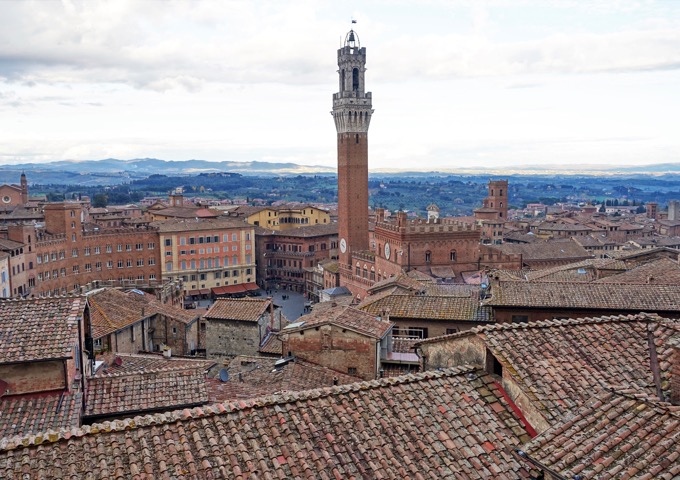
Florence’s historic archrival, Siena, is Tuscany’s second largest city, boasting a wealth of medieval architecture and Renaissance masterpieces. This picturesque city is perfectly walkable with its Gothic streets, palaces, and sacred spaces meticulously preserved and the majority of its streets closed to cars.
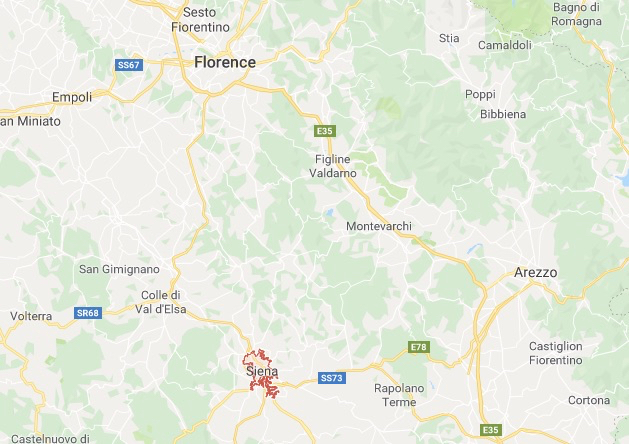
Siena lies about 57 miles (91 km) south of Florence, and is easy to access by car, guided tour, or bus.
How to Get to Siena from Florence
The Best Guided Tour to Siena from Florence
The San Gimignano, Siena, Chianti Guided Tour (from Florence) is excellent and a quick, easy, and affordable way to see some of the Tuscan highlights near Florence.
Taking the Bus from Florence to Siena
The best way to take a day trip from Florence to Siena is to travel by bus. The bus trip doesn’t take significantly longer than driving yourself, you’re free to enjoy the drive through the gorgeous Chianti countryside as you go, and the bus will drop you off right in the center of Siena. The train journey takes longer than busing, is more expensive, lets you off beneath the town at the bottom of a hill, and much of the railway route is through underground tunnels. (That said, the windy roads and hilly terrain can make the train a better option for people who suffer from motion sickness.)
Catch the bus from Florence at the bus depot in Via Santa Caterina da Siena 15, adjacent to the Santa Maria Novella train station – to the left, if you’re outside facing the station. There’s a rapid line express bus (131R) that takes 1 hour 15 minutes, and an ordinary line (131O) that takes 1 hour 35 minutes, passing through a few small towns on the way. Buses run between Florence and Siena 2-3 times per hour Monday through Saturday, and with lesser frequency on Sundays and holidays. A one-way ticket Firenze-Siena costs about 8€, and can be purchased at the station on the day of travel.
It’s a good idea to plan to leave Florence early in the morning, so you’ll have sufficient time to enjoy Siena. You can check the schedule at the bus station the day before to plan your trip.
There is a list of return times at the stop in Siena. To maximize your time in Siena, consider taking the bus there and catching the train back to Florence, as the last train often leaves nearly an hour after the last bus.
Siena Day Trip from Florence
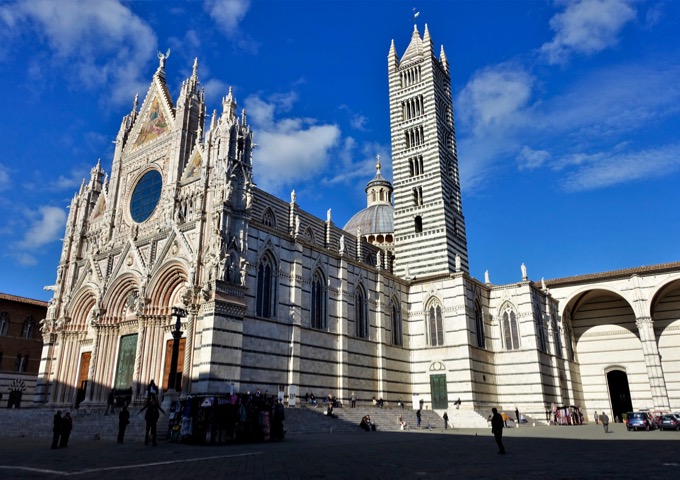
Most of the city’s attractions are within five minutes’ walk of the Piazza del Campo, a shell-shaped plaza, considered one of the greatest medieval squares in all of Europe. Many tours begin here, but if you’re on your own, it’s best to begin at the Piazza del Duomo before the tour buses arrive to see the 13th century Cathedral complex, which includes the Piccolomini Library, Museum, Baptistery, and Crypts.
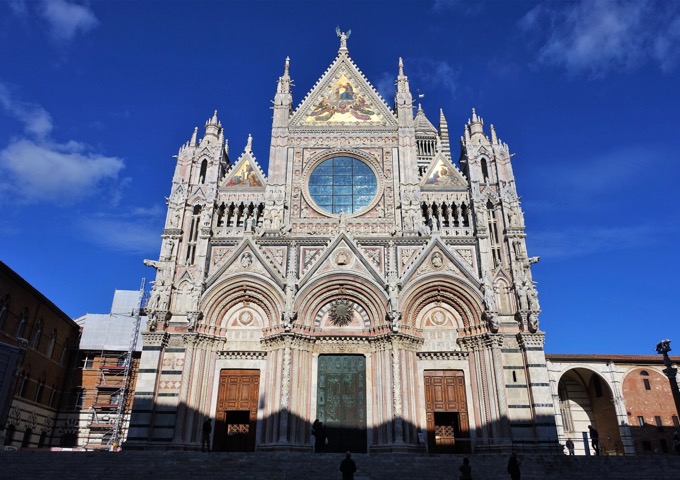
The Cathedral of Saint Mary of the Assumption, usually called the Duomo, boasts an intricate Gothic façade. One of the most stunning in Italy, the white marble face is covered with statues of gargoyles and saints, golden mosaics in each gable, and a bronze sun over the central entrance. Slices of dark green (almost black) marble run horizontally around the whole building. The white and white stripes mirror the Sienese coat of arms.
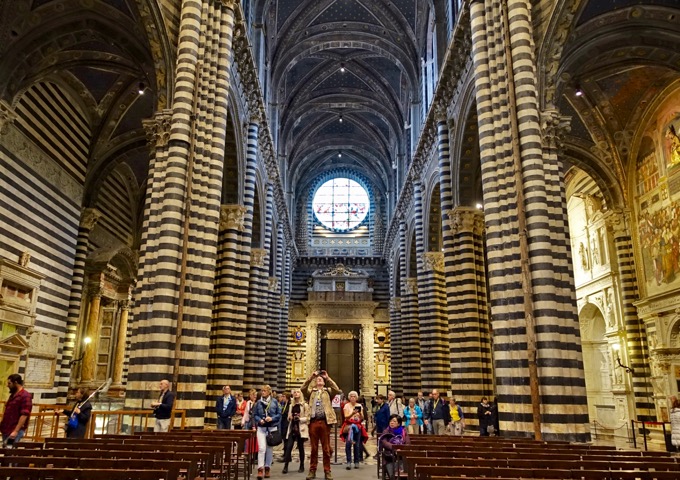
Inside the cathedral, the stripes are more prominent, covering the walls and columns with capitals all topped with animals and busts. Blue vaulted ceilings are dotted with gold stars.
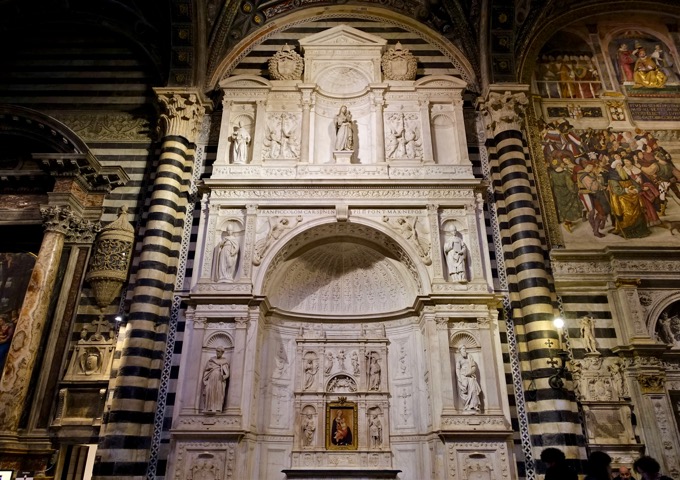
The Duomo is filled to the brim with astounding art. On the left, halfway between the entry and the altar is the Piccolomini Altar, built of Carrera marble by Andrea Bregni. Four of the niche statues (St. Peter, St. Paul, St. Gregory, and St. Augustine (later sculpted into St. Pius) were sculpted by Michelangelo.
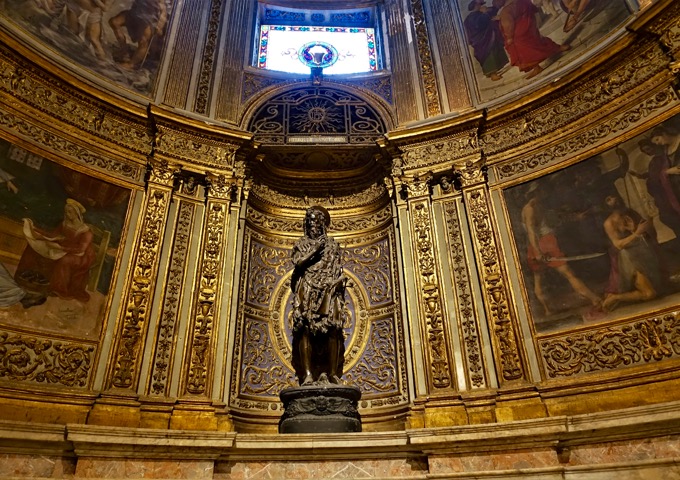
Donatello’s St John the Baptist. Moving toward the altar, you’ll find another Donatello piece, Bishop Pecci’s Tomb. In between Piccolomini Altar and Donatello’s St. John is the Piccolomini Library, a collection of illuminated choir books in a stunningly frescoed room, painted by Pinturicchio.
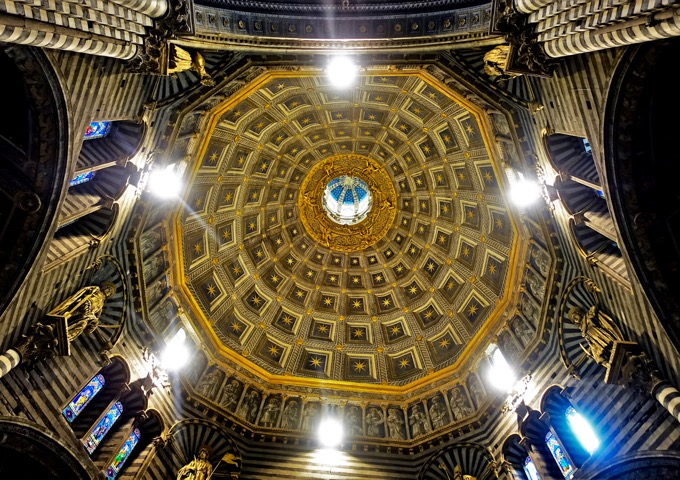
From the center looking up at the dome, there is another smaller dome inside with a gold lantern by Bernini. Several other Bernini works are scattered throughout the cathedral.
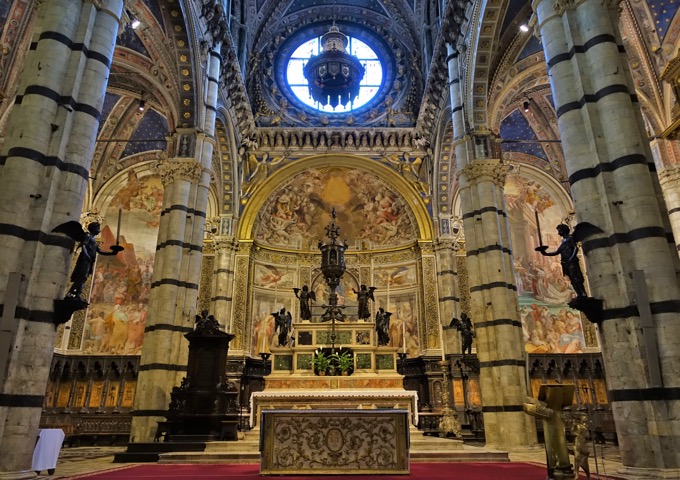
From the center looking up at the dome, there is another smaller dome inside with a gold lantern by Bernini. Several other Bernini works are scattered throughout the cathedral.
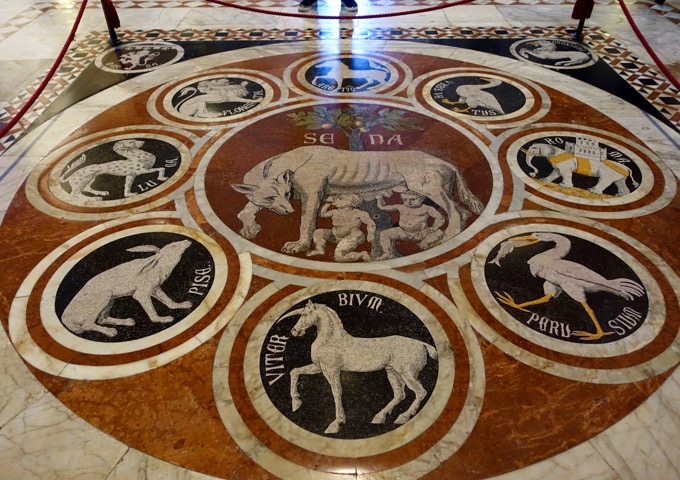
The cathedral pavements are among the most magnificent in Italy, made of 56 panels of marble mosaic inlay and graffito (etched drawings filled with black pitch). For ten months out of the year the floors are covered under a sheet to preserve the centuries-old details, only open to view from June 29 to July 31, and again from August 18 to October 26.
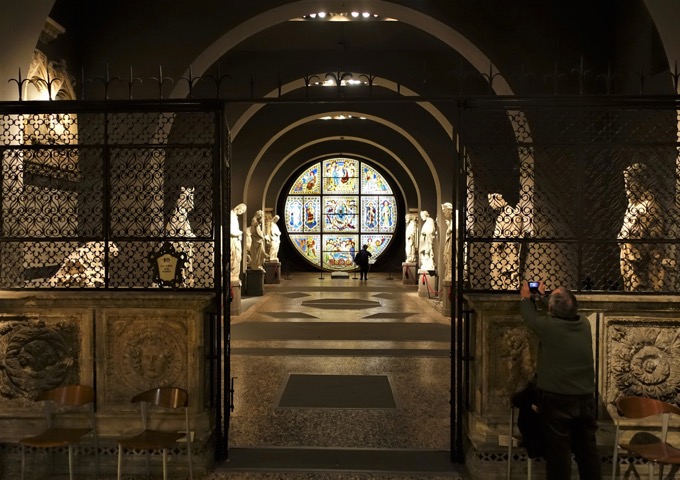
The next stop in the Duomo complex is the Museo dell’Opera, where many of the cathedral’s treasures are now kept, including Duccio di Buoninsegna’s rose window from above the altar and the original 13th century marble statues from the façade. These are all found on the ground floor…
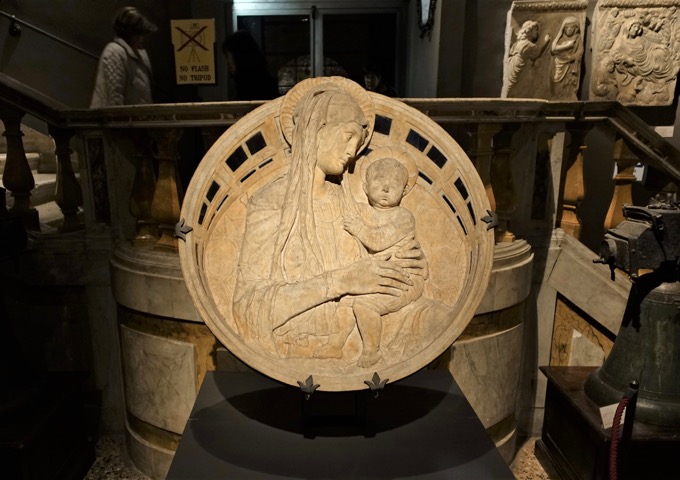
…along with Donatello’s Madonna del Perdono.
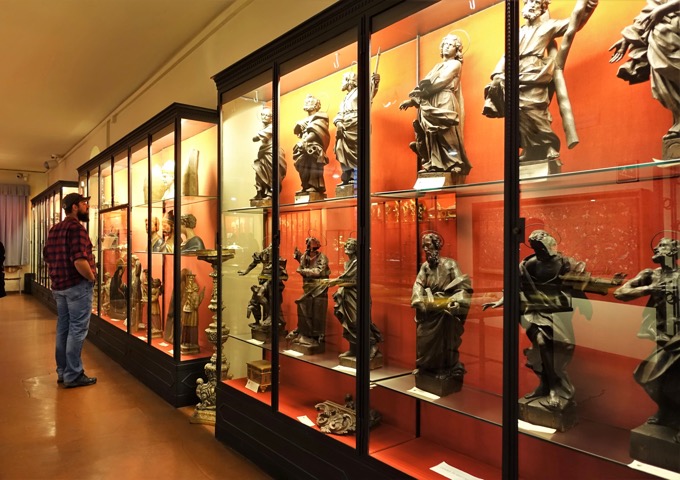
The second floor houses several works of Duccio, most notable the original 14th century altarpiece Madonna and Child Enthroned, considered a masterpiece. Other rooms on this floor house intricate wooden sculptures, illuminated manuscripts, and the Treasury with over 200 sacred liturgical pieces.
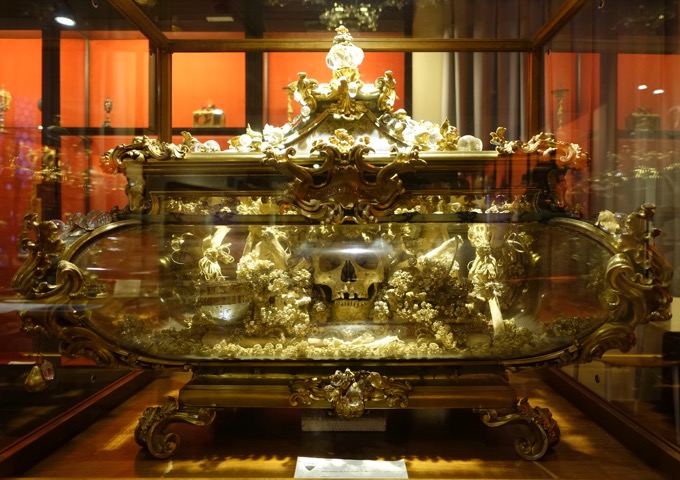
The treasury also boasts a large collection of reliquaries, the elaborately displayed bones of saints.
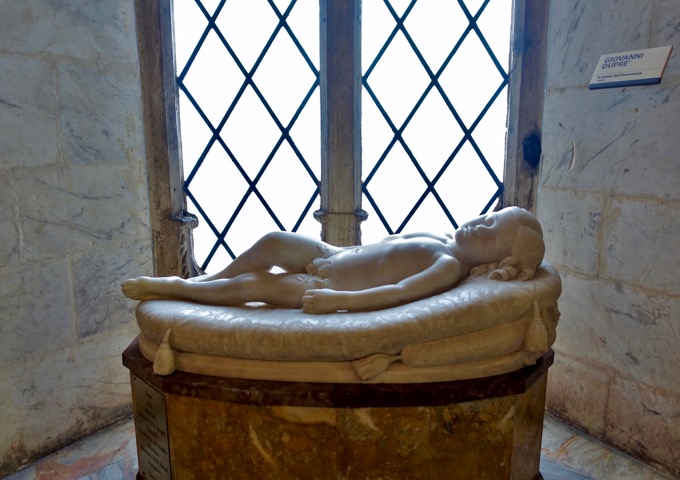
The third floor is home to several more altarpieces, master paintings on wood, and terracotta statues.
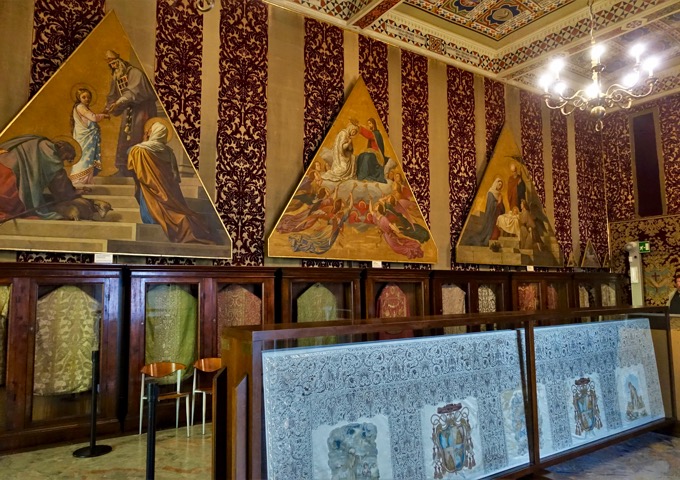
You’ll also find the tapestry room here, with precious textiles and elaborate vestments.
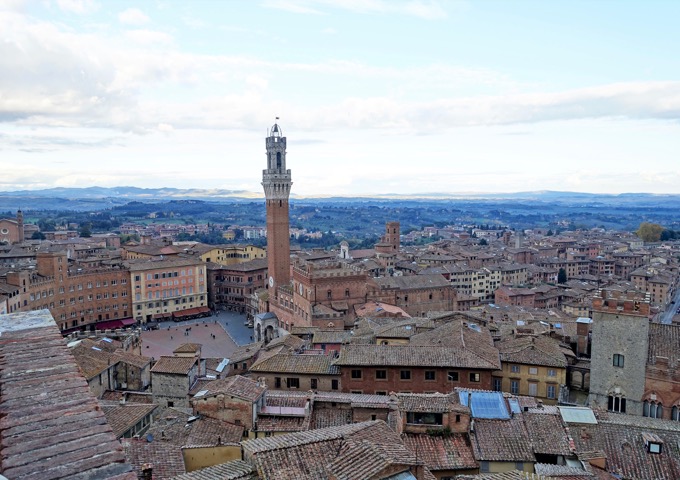
Go through the tapestry room to reach the Facciatone, a historic lookout point with views onto the Piazza del Campo, red tile rooftops, and the Tuscan countryside.
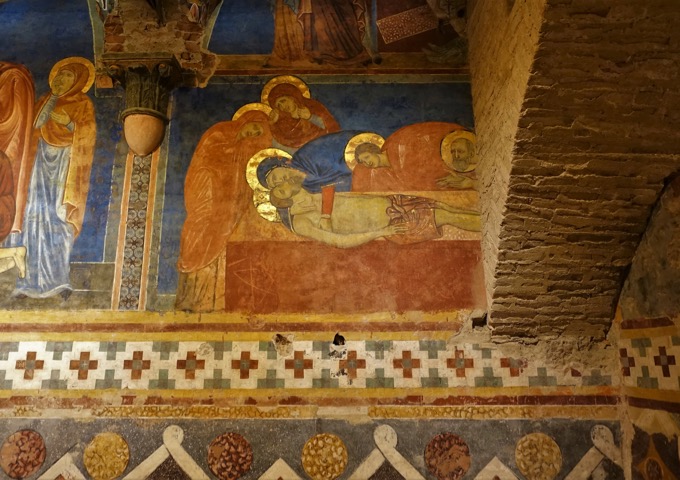
From the museum, continue on to the cathedral’s Crypt, with original frescoed walls depicting the last days of Christ, such as the Last Supper, Washing of the Feet, and the Flagellation, among other scenes. They are not as well preserved or detailed as those in the Piccolomini Library or the Baptistery, but they are worth the visit nonetheless.
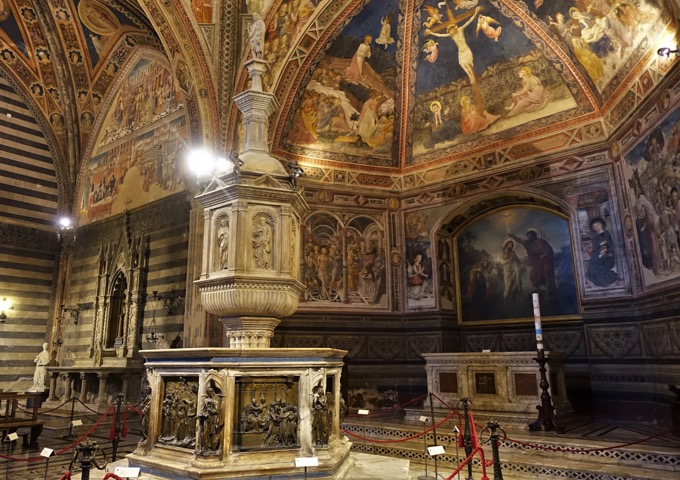
The last stop in the Cathedral complex is the Baptistery, which boasts an ornate baptismal font with sculptures by Donatello, Jacopo della Quercia, and more. The font is considered the main draw here, but spend some time enjoying the opulent frescoed walls and ceilings before heading to the next stop.
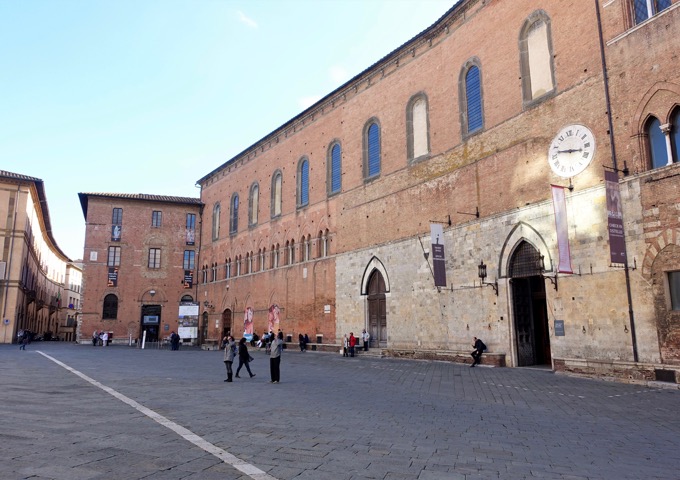
Across the street from the cathedral’s main entrance is the Santa Maria della Scala museum complex, a former hospital dating to the Middle Ages with sacred relics, medical antiquities, and an archaeological museum. This is a large complex with a lot to see, so I recommend setting a timer for yourself if you’re planning on a self-guided walk. Count on spending at the very least 90 minutes here, but two hours is more reasonable. The hospital has only been partially restored, but it still boasts 7 levels taking up over 10,000 square meters. Of course, guided tours are also available, but most of the exhibits are well-labelled in English and Italian, so a guide is not crucial to the experience.
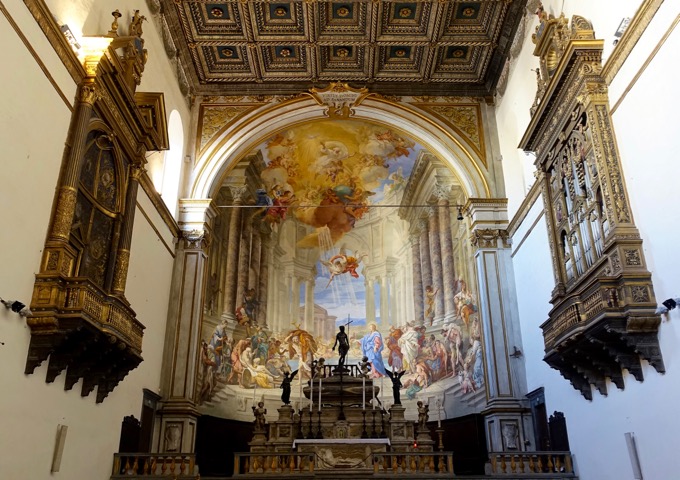
The hospital was originally tended by clergy and lay people who were members of religious confraternities, especially those dedicated to St Michael the Archangel and St Jerome, so visitors will find plenty of Catholic artwork and artifacts, along with several chapels and oratories. The main entrance from the Piazza del Duomo is on Level 4 and leads directly to the Santissima Annunziata chapel, dating to the mid-1200s and beautifully frescoed with stories from the life of the Virgin.
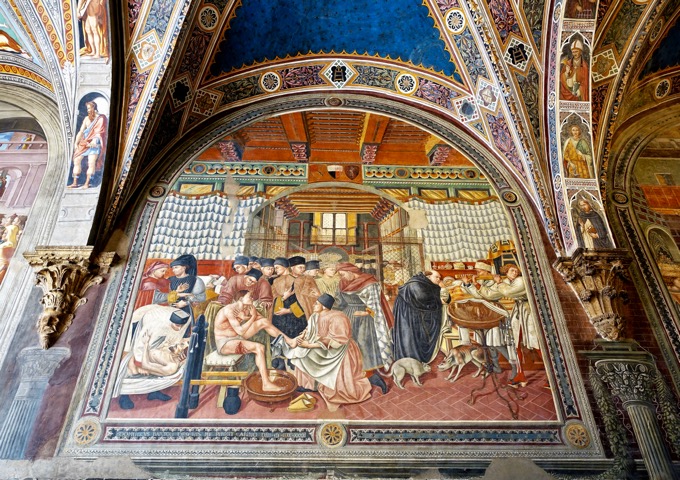
The hospital was unique for providing all services for free, including surgeries. They also took in orphans, fed the poor three times a day, and offered food and shelter to pilgrims. The hospital’s missions were depicted in the 15th century fresco cycle along the hallway known as the Pellegrinaio, also located on Level 4. Panels here represent mostly secular scenes, such as the Government and Care of the Sick, Lunch of the Poor, and the Construction of the Walls of the Hospital, most of which were painted by Domenico di Bartolo.
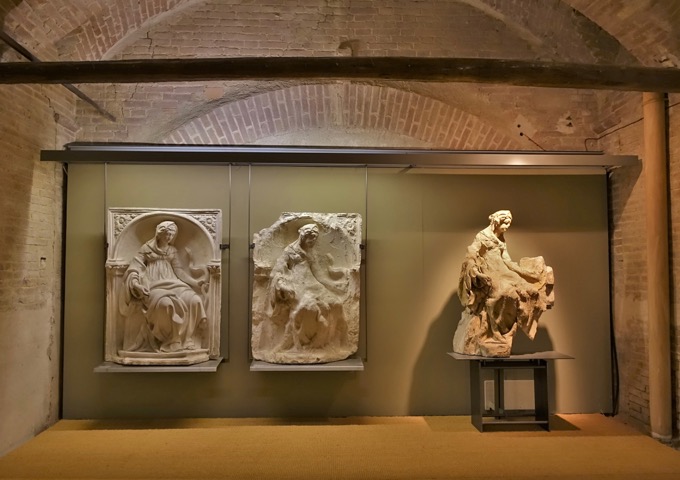
Moving down to the third floor, there is set of rooms in the old granary that displays the original marble statues from Gaia Fountain in Piazza del Campo in various stages of ruin and reconstruction.
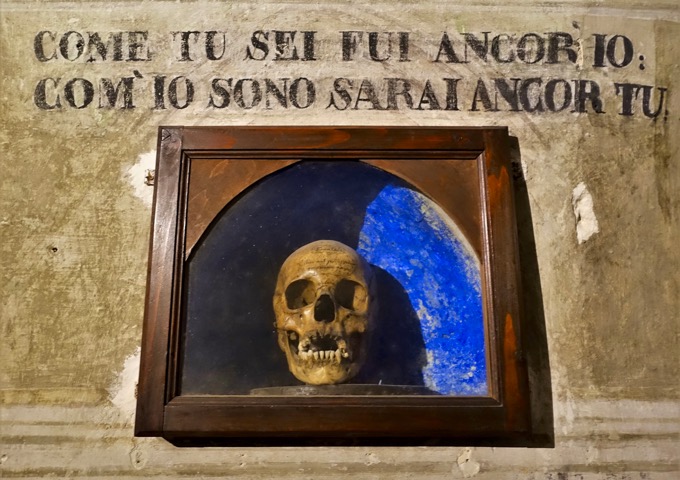
In the heart of the complex on the same floor, where St Catherine of Siena is thought to have regularly come to pray, there is an oratory with relics of the confraternity of St. Catherine of the Nights, named such after St Catherine’s canonization. Members of this brotherhood were devoted to caring for the deceased.
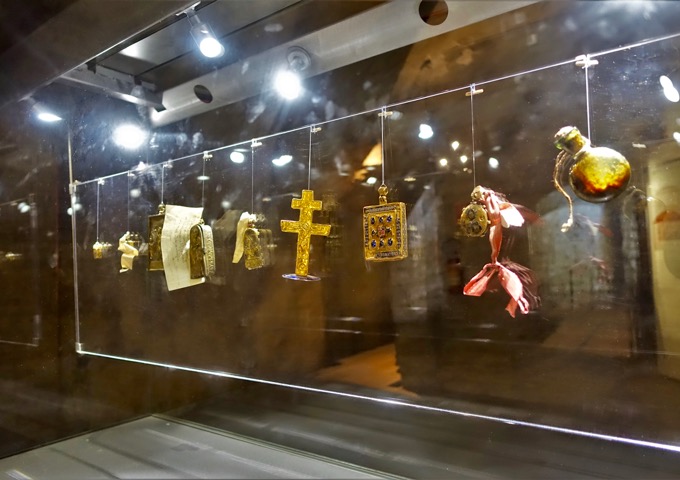
Another room houses religious artifacts once used in processions, including reliquaries.
One section is devoted to the infirmary kitchen, collecting the vessels used to cooking and medicinal preparations.
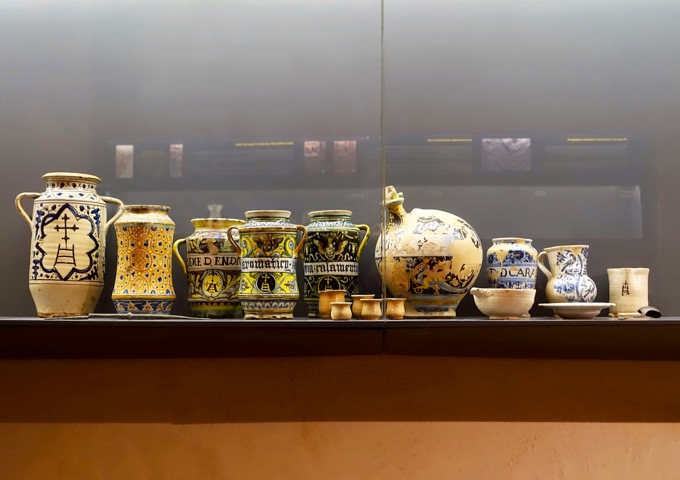
One section is devoted to the infirmary kitchen, collecting the vessels used to cooking and medicinal preparations.
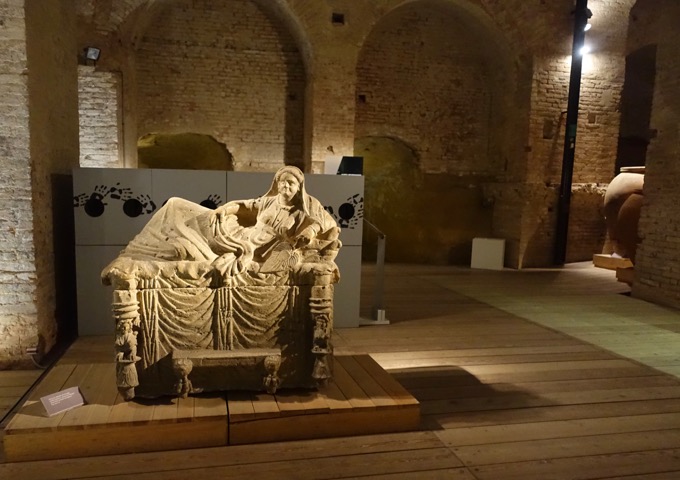
Heading down the old internal road of the hospital to Level 2, you’ll find the Archaeological Museum, housing artifacts from the Sienese medieval era and ancient Rome.
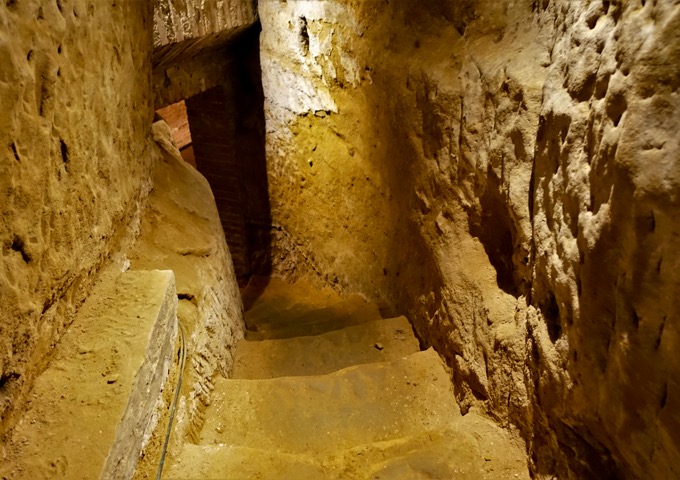
Branching off the internal road are several cells and tunnels, some leading down to Level 1.
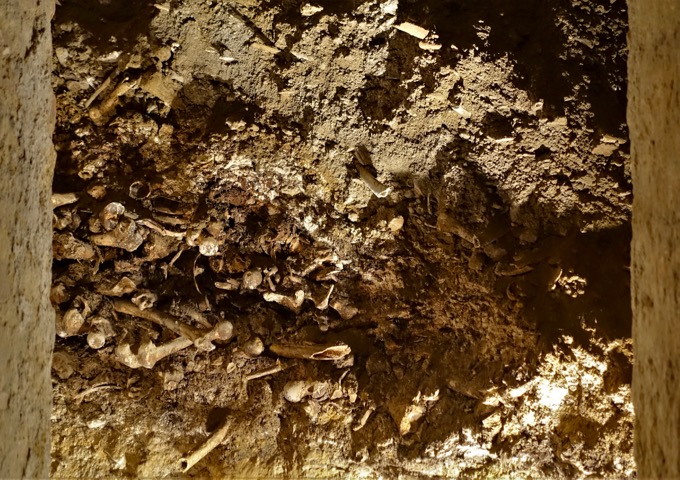
Following the tunnels down leads to the hospital’s mass grave used for pilgrims and the poor who died in the hospital. The bones here date from the 13th through the 15th centuries.
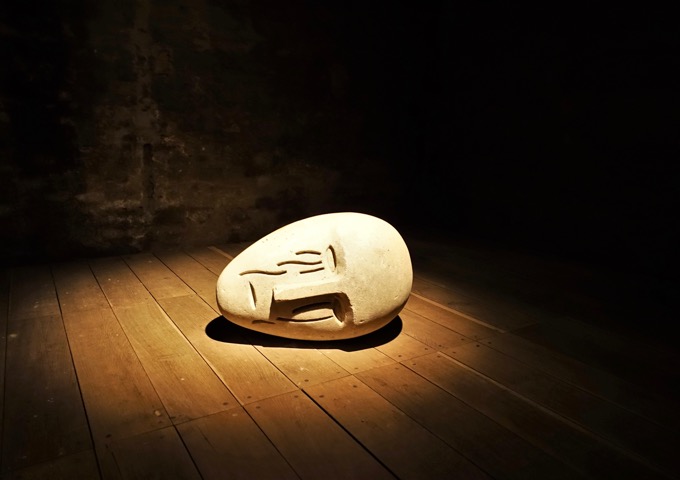
Making your way back up, you may come across an odd piece or two of modern art, looking a bit out of place in the old hospital. Floors 5 through 7 were the women’s areas of the hospital and pilgrims’ quarters. There are no major artworks here; the space is mostly used for temporary exhibits and events.
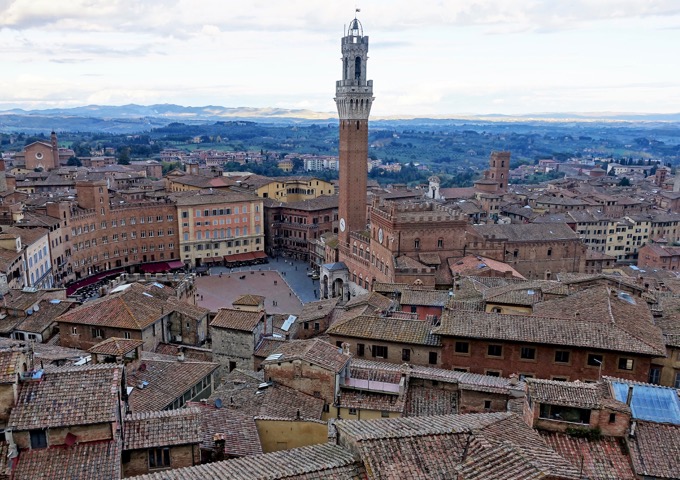
Head to the Piazza del Campo next, a gorgeous red brick and travertine “square” with a fan shape and scalloped edges, considered one of the greatest city squares in Europe.
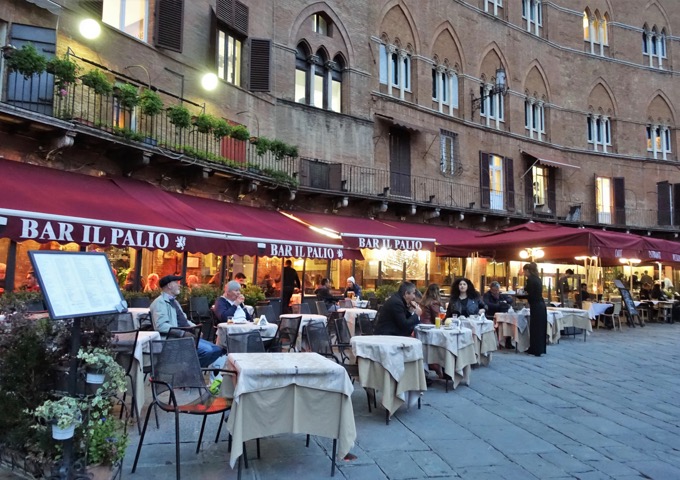
You’ll find several cafes and restaurants along the square offering great food and views of the Palazzo Pubblico. The Gaia Fountain is also here, though it is currently under restoration.
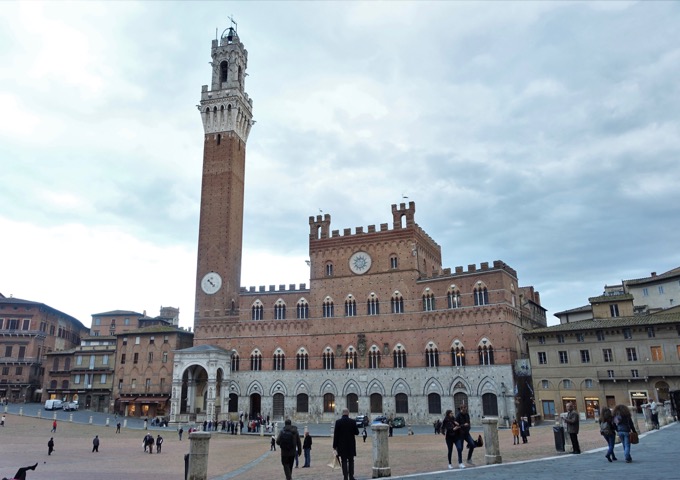
The 13th century Palazzo Pubblico is the town hall and main attraction in the Piazza, known for its medieval and Gothic architecture, its unusual collection of secular frescoes, and its bell tower, the Torre del Mangia. The Palace was built to house the Nine Lords who ruled over Siena.
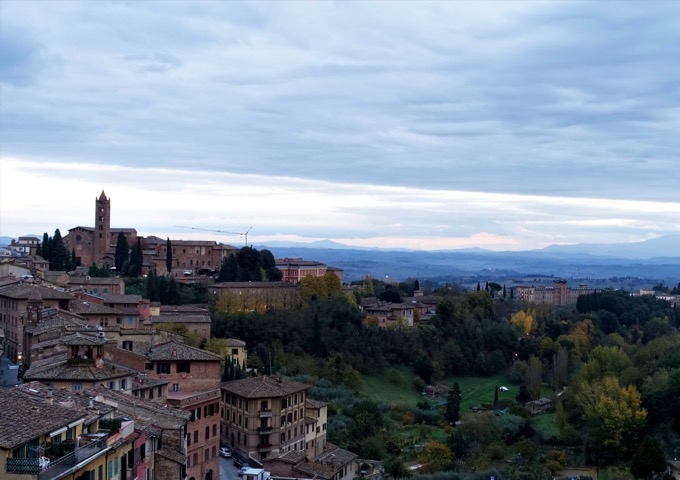
If purchasing combo tickets for the Civic Museum at the Palazzo and the Torre del Mangia, you must climb the tower first. The Torre del Mangia is the second tallest tower in Italy, designed with the explicit intent of being as tall as the Siena Duomo, to signify the state and church sharing equal power, and taller than Florence’s Palazzo Vecchio, the tallest tower of Siena’s rival. The tower is 88 meters tall, spread over 400 steps, offering stunning panoramic views of the city and the square.
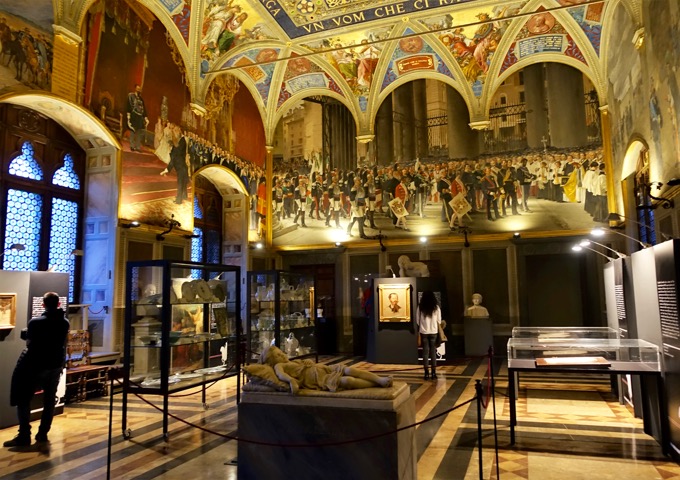
The Civic Museum inside the Palazzo is small, though its collection is important and impressive, with notable works by several Sienese master artists, including several iterations of the city’s symbol, the She-wolf of Siena nursing Romulus and Remus.
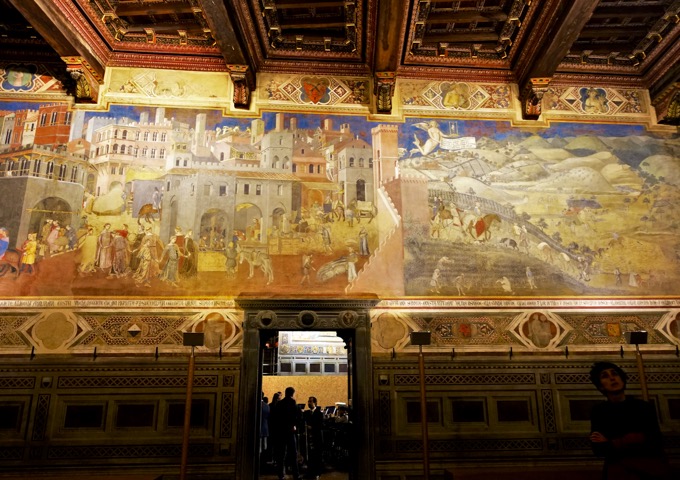
The frescoes are the most important artworks here, especially Allegory of Good and Bad Government by Ambrogio Lorenzetti…
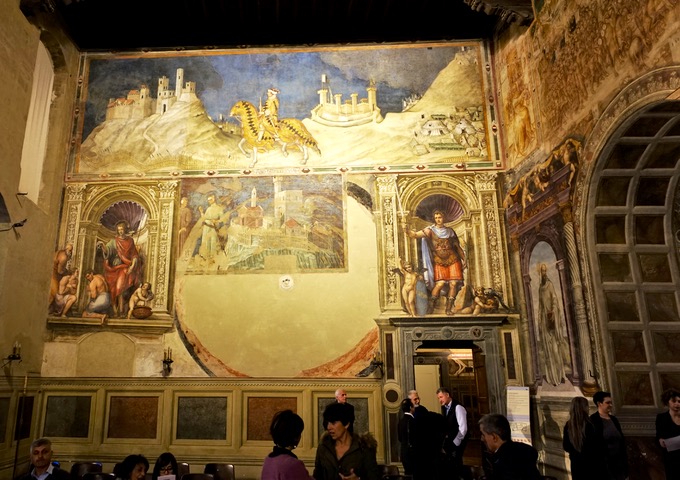
…and the Guidariccio da Fogliano by Simone Martini. Martitni’s The Majesty is on the wall opposite the Guidariccio.
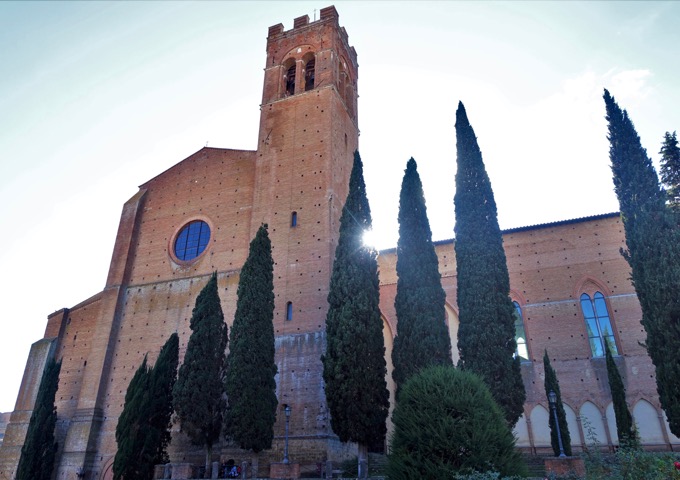
Finally, if you have time and energy, visit the Basilica Cateriniana di San Domenico, a thirteenth century church dedicated to St. Catherine.
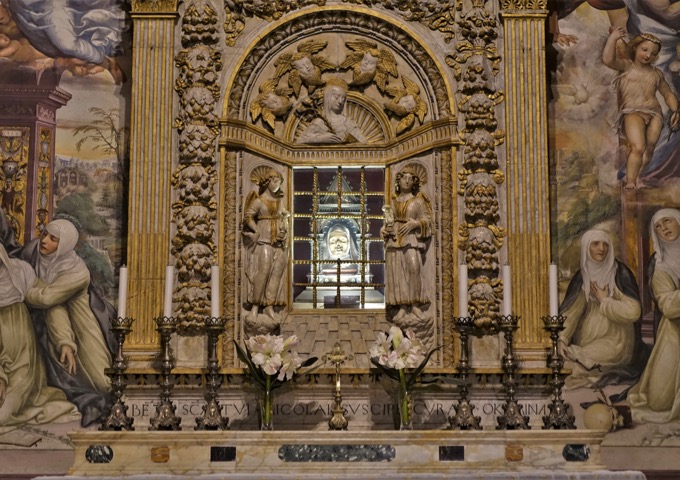
Born in Siena, St. Catherine is the most important figure of the city and one of Italy’s two patron saints, along with St. Francis of Assisi. After her death, her head was removed and brought back to Siena, where it is currently displayed in the Basilica.
Siena Attractions: Hours and Rates
Combo Tickets:
Acropoli Pass: Entry to the entire cathedral complex and Santa Maria della Scala: €13-20 depending on time of year; Kids’ rate is €2 year-round.
Siena Duomo Complex Opa Si Pass: Entry to main sites in Cathedral (Duomo, baptistery, crypt, Piccolomini Library, and the Museo dell’Opera): €8-15 depending on what time of year it is.
Cathedral: Weekday Mass: 9:00, 10:00 / Weekend/Holiday Mass: 8:00, 11:00, 12:15, 18:00
Cathedral and Crypt: Weekday/Saturday Hours: 10:30-17:00 / Sunday Hours: 1:30-17:00
Piccolomini Library: 10:30-17:30
Museo dell’Opera: 10:30-17:00
Baptistery: 10:30-19:00
Palazzo Pubblico Civic Museum:
10:00-18:00, €9 for adults, €8 for children and seniors
Torre del Mangia:
10:00-19:00 in summer (ticket window closes at 18:15);
10:00-16:00 in winter (ticket window closes at 15:15)
€10, children under 11 free
Basilica di San Domenico/St Catherine’s Basilica:
March-October: 7:00-18:30
November-February: 9:00-18:00
Weekday Mass: 7:30, 16:00
Weekend/Holiday Mass: 7:30 and 18:00 in the Basilica, 10:00 in the Crypt
Free admission
About Santorini Dave